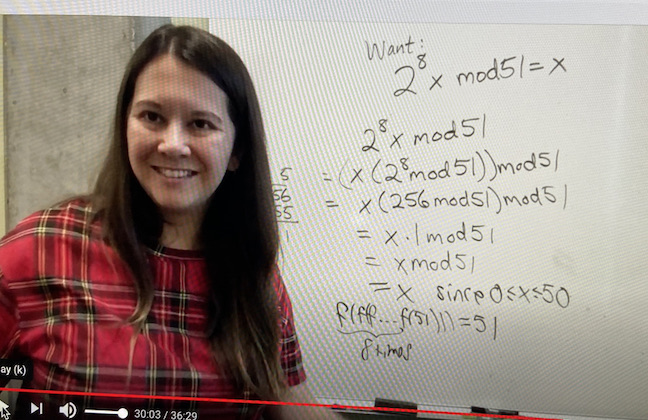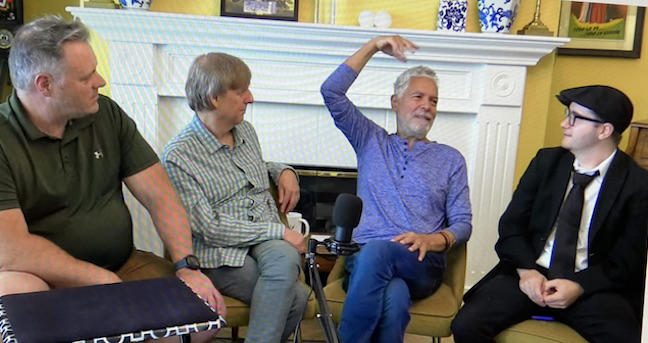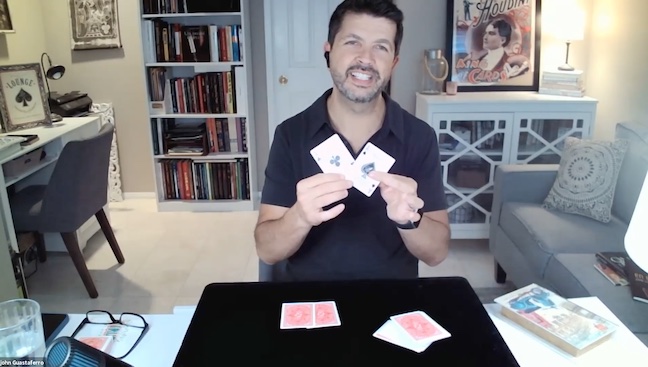
WELL STRUCTURED — If you have ever wanted a complete magic show to blow away intelligent audiences, Caleb Wiles has a lecture for you. Straight out of the chute, Caleb was recognized as a genius creator of individual magic tricks. But not until this Penguin Caleb Wiles LIVE lecture have I seen him apply his talent to the structure of an entire show. There are many levels of deception, tightly choreographed subtle elements set to stun. Yes, you can perform any of the tricks on its own, as enthusiastic host Dan Harlan interjects, but the cumulative effect of weaving methods together makes reconstruction impossible. Some feats are foreshadowed, some post-trick convincers are added. So what happens? The magic is both visual and cerebral. A card box vanishes (“fades away”). (Noted: We like to get one ahead in magic. At this point in the show Caleb is 20 minutes ahead.) An isolated card, never touched again, becomes any card named. A blank deck becomes a normal printed deck. The isolated card becomes the money card in a three-card monte sequence. Two selected cards, one at a time and then the deck itself, are found under an empty card box (shades of Albert Goshman!). One of them, a black eight, drops from the card box as an eight ball. As a Tribute to Harry Riser, four jacks re produced from a deck, they become aces, the missing jacks are produced from pockets, the aces vanish and are reproduced, and the deck vanishes and reappears in the empty box! Quadruple exclamation point! The 20-minute show climaxes with 26! (“26 factorial”), Caleb’s famous, brilliant, and bold approach to Sympathetic Cards. This is a fun ride.

Efficient stacking (the show seemingly takes place with one deck, though three are actually used) and some standard sleight-of-hand moves (none too difficult) accomplish all the dirty deeds, and the moves are so well covered that you won’t hesitate to execute them. This is a show you will be proud to perform.
But wait, there’s more! A Penguin subscriber himself, Caleb has watched 160 Penguin LIVE lectures and is at ease teaching. He includes a four-part set and prop list, handy for anyone who doesn’t perform regularly and especially for an act as highly interrelated as this one. As a bonus, beyond the show itself, Caleb teaches his Fully Automatic Card Trick that he debuted on Penn and Teller. A Penguin download, 143 minutes, $39.95.

PERFECTION — As most magicians know, eight perfect out-faro shuffles will return a 52-card deck to its original order. (I did not know, or at least remember, that it takes 52 in-faro shuffles to achieve the same result. It would take a patient audience to watch that version of UNSHUFFLED.) Not only does this unexpected result occur, but Indiana University professor and accomplished Magic Castle close-up magician Tori Noquez can prove it. Check here for Tori’s enjoyable journey through the intricacies of a proof using modular arithmetic, followed by an empirical proof as she executes eight faros in her own hands. I recall Groucho Marx’s boast: “Those are my principles, and if you don’t like them … well, I have others.” If you don’t like Tori’s modular arithmetic proof, she has another, using combinatorics, that she posted a year earlier.

Neither her PhD in math nor her extensive practice with a deck has gone to waste. The mix of talents also makes for entertaining magic, as she deftly combines her doctorate-in-math character with her card magic skills. She has a teacher’s authority over an audience that I haven’t admired this much since the days of Dave Tansy. Highest marks.
WOODY PREDICTS — Back in November 2018, I enthused over Woody Aragon’s Fortune Tarot, $19.95 from Penguin. Faithful readers will recall that it is not a Tarot effect at all, but rather a three by three magic square formed by nine ordinary cards produced from a spectator-shuffled deck. The common magic squre total matches the quantity of cards initially cut off by a pectator. The method and effect are amazing.

Lately I have been toying with the routine, and I like Simon Aronson’s idea of using a magic square for tongue-in-cheek fortune telling (see Square Deal in Art Decko).
If you stack the deck per Woody’s instructions, the spectator must cut between 9 and 19 cards. (If you pencil mark the 10th through the 20th cards, you will see that he has cut into the desired range.) Given that cut, the magic square total will range from 9 to 19; that is the basic effect of the routine. This has advantages: spectators will not have to add largish numbers, and the totals lend themselves to the following patter.
“This row represents travel, this one wealth, and this one romance.” You can so designate any of the rows. Per the routine, some cards are face-up, some face-down. Turn the down cards up to reveal the magic square. “Look: 2 plus 4 plus 3 is 9. You will travel Europe on 9 dollars a day. Fantastic! And this row: 6 plus 2 plus 1 is 9. You may amass 9 million dollars in your lifetime. Wonderful! And this one: 1 plus 3 plus 5 is 9. Nine lovers! Awesome! But look at this column: 2 plus 6 plus 1 is also 9. And this column: 4 plus 2 plus 3 is 9. And this one: 3 plus 1 plus 5 is 9. Or this diagonal: 2 plus 2 plus 5 is 9. Or this …” Here you pick up four cards per instructions to generate a second, somewhat wonky diagonal. “Three plus 1 plus 2 plus 3 is 9. But that doesn’t matter.” Sweep the cards aside and retrieve the initially cut-off packet, attempting to gauge its weight. Count them to the table. “I can tell simply by the weight of these cards that you have 1, 2, 3, … 7, 8, 9 cards. I’d say your lucky number is …”
That’s it. Woody’s trick is nearly self-working and should give you no trouble. However, should something go wrong, you will know it before the spectator, and you can merely skip the “magic trick” portion of the routine and pass the whole thing off as an entertaining bit of fortune telling. Neat!

With the possibility of magic returning to live performance (a possibility recently in doubt), the quantity of magic on the internet has dropped precipitously. Still, some exists. It is like a Sunday following a convention that ended on Saturday night. You still might see an old friend or a magical hero in the lobby, but he is standing next to his luggage and awaiting a taxi. The fun is over, for a time.
Likewise, some new material still streamed to our homes. Just not as much ...
BACK TO DON’T EVERYBODY LEAVE — Mac King’s 21st and 22nd episodes featured Clint Holmes, the fabulous singer with whom Mac used to share a theater. Clint is the son of a jazz singer dad and an opera singer mom and has lived a life full of great stories. Another reason to watch these? Mac kills with an ACAAN! Look this up if you haven’t seen it. It will fool you. Badly.

The entire cast gathered in person for the 23rd and 24th episodes, with Jeff McBride. 1In part one, Jeff related tales of bloody gore on stage, stuff that Amazing Johnathan only fakes. In part two, he discussed his life as a carnival hustler with the game Razzle and his working for Diana Ross, and he introduced his “cousin” Clive McBride for a joke and a magic trick.
And then, alas, Mac has announced that the show is on hiatus, with thanks to all for watching Season One. Come back soon!
BACK TO BEHIND THE BOOKCASE — By the episode …Episode 113: Gay Blackstone hosted An Evening with Jeff McBride. This was delightful, and I don’t think I had ever seen Jeff interviewed before. Tidbits included Jeff’s first meeting with Eugene Burger (1987) and that Milt helped with the design of the sliding bookcase in Jeff’s home. The interview made a nice companion piece to Jeff’s recent MagicQuest.

Episode 114: Jonathan Levit and Christopher Hart hosted An Evening with Ben Roman. Who is that, you say? Well, when the Magic Castle’s paid staff dwindled from 200 to 4, Ben was one of the four, and it is arguable that he did the work of 200. His official title is Director of Events, and in normal times that meant anything from arranging a hotel for Carol Channing to negotiating with film crews. During the pandemic, it meant a breathtaking list of chores, from parking lot events to packing and shipping stuff ordered through the gift shop. His complete list of duties is staggering.

BACK TO TUESDAY ONLINE LECTURES — Readers know that I am a big fan of John Guastaferro and have reviewed most of his publications herein. It was a nice surprise to access his recent Magic Castle lecture online, with a generous representation of his material. I was picked to participate in Color Blind, and we did well! My favorites that he demonstrated were Spectral, from Ready, Set, Guastaferro, and Mini-Mental from en route. The former is the vanish nd resurrection of a card from among 15. The latter is a great multiple selection routine with only four selections. I’d love to make magic look this swell.





